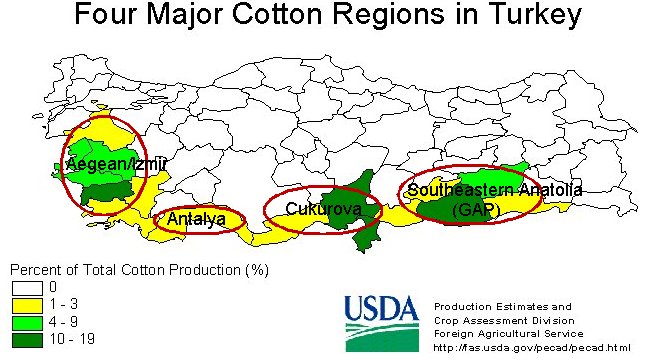Food inflation is now an issue, as the impact of the Lira collapse is being fully felt. Recently, the attention has been on onions, which have tripled in Lira terms over the past year. The sharp increase in this staple food has caused the government to come out against the farmers, and attempt to stop any hoarding. Could this indicate that the government will attempt to boost food crop protection and be unwilling to increase the price support needed for cotton acreage to be maintained?
Turkey planted a large acreage to cotton in 2018/2019, but the results were not good. Grower returns were reduced by excessive rains at planting, and again at harvest, reducing quality and yields. In addition, the Lira collapse occurred before the 2018 harvest, which reduced returns. Acreage in 2018/2009 surged to 560,000 hectares from only 400,000 hectares in 2016/2017. However, production declined to 3.7 million bales due to the weather issues.
After the sharply lower yields and returns of 2018, 2019/2020 acreage would appear set to fall sharply. The average farm size is about 9.5 hectares, and growers depend on a government subsidy to keep the crop profitable. The government raised the subsidy for six straight seasons thru 2017/2018, and left it unchanged in 2018 at .80 Lira per kilogram of seed cotton. Just to keep the subsidy at the same level in 2019 will mean an increase of 30-50%. Such an inflationary increase may be something the government is unwilling to do, because it is just too expensive. Approximately 80,000 farmers grow cotton. The incentive, especially in the Aegean and Cukuriva belts, may be switched to food crops. The financial woes of the Lira crisis have also slowed the expansion of the GAP irrigation scheme.
Early indications suggest cotton acreage could fall back to the 370,000-hectare level, which would suggest production may total no more than 2.7 million bales. Textile/apparel exports have been expanding, supporting domestic consumption, but the weaker European economy is causing some concern. Consumption could reach the seven million bales level, which would set the stage for a rebound in cotton imports to near the 4.2-4.3 million bales level. The sharp decline in international price levels and the availability of US long staple lower color grades at record discounts is again stimulating import offtake. Turkish mills were very active buyers of US, Brazilian, and Greek styles last week.
Πηγή: Jernigan Global


